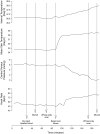Effects of passive heating on central blood volume and ventricular dimensions in humans
- PMID: 17962331
- PMCID: PMC2375541
- DOI: 10.1113/jphysiol.2007.143057
Effects of passive heating on central blood volume and ventricular dimensions in humans
Abstract
Mixed findings regarding the effects of whole-body heat stress on central blood volume have been reported. This study evaluated the hypothesis that heat stress reduces central blood volume and alters blood volume distribution. Ten healthy experimental and seven healthy time control (i.e. non-heat stressed) subjects participated in this protocol. Changes in regional blood volume during heat stress and time control were estimated using technetium-99m labelled autologous red blood cells and gamma camera imaging. Whole-body heating increased internal temperature (> 1.0 degrees C), cutaneous vascular conductance (approximately fivefold), and heart rate (52 +/- 2 to 93 +/- 4 beats min(-1)), while reducing central venous pressure (5.5 +/- 07 to 0.2 +/- 0.6 mmHg) accompanied by minor decreases in mean arterial pressure (all P < 0.05). The heat stress reduced the blood volume of the heart (18 +/- 2%), heart plus central vasculature (17 +/- 2%), thorax (14 +/- 2%), inferior vena cava (23 +/- 2%) and liver (23 +/- 2%) (all P </= 0.005 relative to time control subjects). Radionuclide multiple-gated acquisition assessment revealed that heat stress did not significantly change left ventricular end-diastolic volume, while ventricular end-systolic volume was reduced by 24 +/- 6% of pre-heat stress levels (P < 0.001 relative to time control subjects). Thus, heat stress increased left ventricular ejection fraction from 60 +/- 1% to 68 +/- 2% (P = 0.02). We conclude that heat stress shifts blood volume from thoracic and splanchnic regions presumably to aid in heat dissipation, while simultaneously increasing heart rate and ejection fraction.
Figures




Comment in
-
Human cardiovascular responses to passive heat stress.J Physiol. 2008 Jan 1;586(1):3. doi: 10.1113/jphysiol.2007.147215. Epub 2007 Nov 1. J Physiol. 2008. PMID: 17974585 Free PMC article. No abstract available.
References
-
- Cai Y, Holm S, Jenstrup M, Stromstad M, Eigtved A, Warberg J, Hojgaard L, Friberg L, Secher NH. Electrical admittance for filling of the heart during lower body negative pressure in humans. J Appl Physiol. 2000a;89:1569–1576. - PubMed
-
- Cai Y, Jenstrup M, Ide K, Perko M, Secher NH. Influence of temperature on the distribution of blood in humans as assessed by electrical impedance. Eur J Appl Physiol. 2000b;81:443–448. - PubMed
-
- Crandall CG, Levine BD, Etzel RA. Effect of increasing central venous pressure during passive heating on skin blood flow. J Appl Physiol. 1999;86:605–610. - PubMed
-
- Cui J, Wilson TE, Crandall CG. Muscle sympathetic nerve activity during lower body negative pressure is accentuated in heat-stressed humans. J Appl Physiol. 2004;96:2103–2108. - PubMed
-
- Eisalo A. Effects of the Finnish sauna on circulation. Ann Med Exp Biol Fenn. 1956;4(Suppl.):7–96.
Publication types
MeSH terms
Grants and funding
LinkOut - more resources
Full Text Sources
Other Literature Sources
Medical
Miscellaneous

